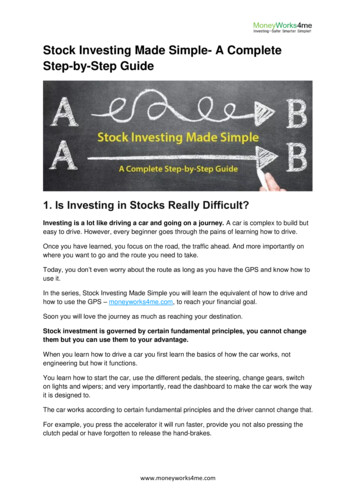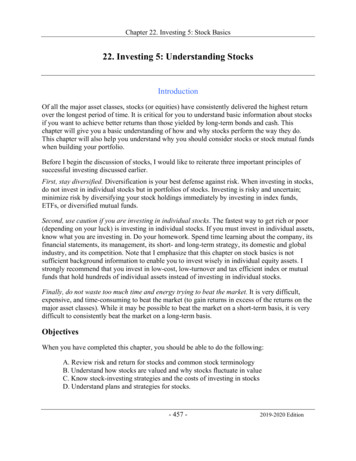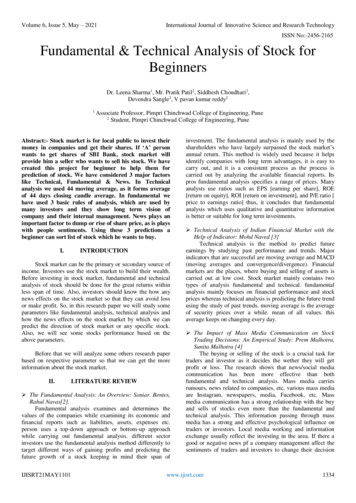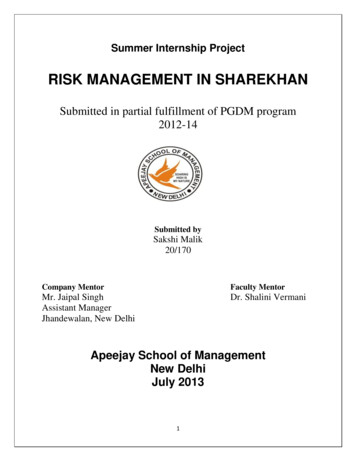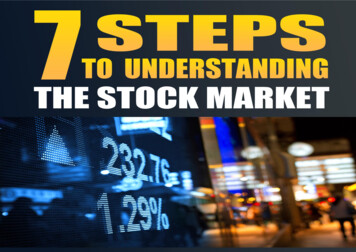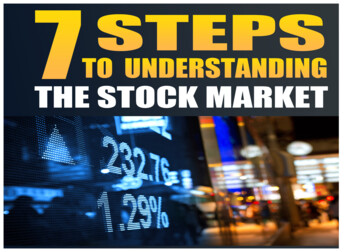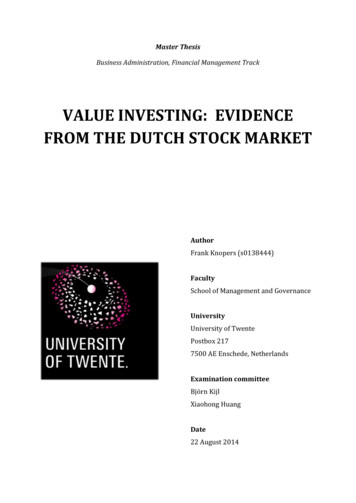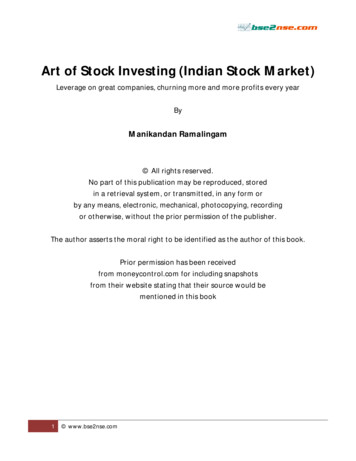
Transcription
Art of Stock Investing (Indian Stock Market)Leverage on great companies, churning more and more profits every yearByManikandan Ramalingam All rights reserved.No part of this publication may be reproduced, storedin a retrieval system, or transmitted, in any form orby any means, electronic, mechanical, photocopying, recordingor otherwise, without the prior permission of the publisher.The author asserts the moral right to be identified as the author of this book.Prior permission has been receivedfrom moneycontrol.com for including snapshotsfrom their website stating that their source would bementioned in this book1 www.bse2nse.com
Table Of ContentsMain Topics DiscussedIntroductionWhy & How Stock Markets Came Into Existence?How & Why Does A Share Price Rise & Fall?Some Basic Terms of Stock MarketsMarket CapitalizationEarnings Per Share (EPS) & (P/E)Where Can I Check All These For A Company?Art Of Picking Worthy StocksDebt & Cash Equivalents of a CompanyBrand Value of a CompanyCompetition & Future Growth ProspectsGrowth Consistency of a CompanyPower Of CompoundingStock Recommendations - Evergreen StocksCommon Mistakes To Stay Away FromBetter Times To Buy & Best Times To SellBetter Times To BuyBest Times To SellGold ETF'sSome Personal AdviceWhat About Mutual Funds?Summary or Re-cap of the BookYour FeedbackDisclaimer2 www.bse2nse.com
AcknowledgementsMy parents are the reason for what I am today. So I cannot thank them enough. I also want to thank,all the teachers who taught me at AECS School, Kalpakkam.Then, a big thank you to Jagadeesh Balu who was my batch mate at College of Engineering Guindy forintroducing me to the world of stock investing in the 3rd year of College. Some more to Karthicknarainand Arunganesh who are also my batch mates at CEG.I also want to thank moneycontrol.com,for letting me include snapshots from their website. But forthat, the book would have lost the power of communication.3 www.bse2nse.com
IntroductionA lot of people call or believe investing in stocks is gambling. A true investor would appreciate it beingcalled risky.It’s like the belief, that getting into sea waters or a pool is risky. But someone with the right swimmingskills would know, when and where to swim to enjoy it.My Mom is a strong believer that, investing in land or house is the safest thing to do. Yes, it truly is,with the growing population and increasing purchasing capacity in India bidding to own a piece oflimited space of land that’s available. But it becomes a locked asset, which you would never plan or beable to sell or liquidate or leverage on. No need to mention that, you would commit 20 years of yourlife to a job you don’t like (To pay EMI), with no option to escape. It also has problems likemaintenance, litigation issues, encroachment and so on.The true value of a land is never transparent and brokers make sure you buy higher and sell lesserwhen you have to. That’s why my Mom hates the selling part. Since the true value is not transparent,no selling price is satisfying enough. The main problem for me is, i cannot buy a piece of land forRupees 3000, Can I now? Which would be a common man's monthly savings, which he would prefer toinvest. And i cannot sell a piece of land on the day i want to. My dad took 2 years to sell a piece of landin Chennai City and the buyer took a year to pay back in installments. And the whole process is sodamn frustrating to say the least. My simple piece of advice: If you buy a land or house, don’t get intoa situation with a need to sell it any time in the future. You can buy a house to live in it. There’s nothingwrong with that. Buying a house or land purely as investment is a pain, though it gains in value over 20years (Half your life is over by then). And you are left to contemplate if you bought and sold at the rightgoing price.You can invest in any corner of Indian Soil and expect it to grow in value over 20 years. The same is nottrue about investing in stocks listed in Indian Stock Exchange. 99% of stocks listed in Indian StockExchange, would not be worthy of being invested in at all times (Economy / Financial Markets, hasgood and bad moods too like human beings). This is why investing is considered an art, for those withthe knowledge of Financial Markets*. The critical aspect of this art is to cherry pick the worthy stocks,which would fall the least during bad times and appreciate well in value over a period of time. Thereare other add-on aspects of course, like better times to buy and best times to sell.An investor needs to be empowered with the basic fundamental knowledge of Financial Markets. It’sunfortunate, that people in India who invest in stocks & mutual funds (to save on Tax) lack thisknowledge. This book will un-cover the basic fundamentals of Indian Stock Markets & generally anystock market really. I intend to make this book as short as possible and to the point with no intentionto confuse you.Financial Markets* - Includes Stock Market (Equity Markets), Bond Markets, Commodity markets, Derivatives Markets and so on.4 www.bse2nse.com
Why & How Stock Markets Came Into Existence?To understand the very basics of stock markets, you should know why they came into existence. Whydid anyone need a Stock Market? The answer is simple: Stock Markets came into existence becauseCompanies or Businesses needed them.Let’s try to understand this better. Why would companies or businesses like TCS or Infosys need IndianStock Markets? Infosys was founded on 2nd July, 1981 by N. R. Narayana Murthy and 6 others with aninitial investment of Rupees 10,000 officially becoming the first employees of the company. The 10,000Rupees would have been sufficient only to start Infosys, but they cannot run and expand their businesswith that forever. As you can obviously figure out now, they would need more funds to run and expandtheir business.Where will the fund they need come from? The little profits, if any they make, in early stages of a company wouldn't be enough to fuel theambitious expansion plans they must have had. Taking debt or loans from Banks is one option. But, it sadly needs to be paid back with interest.And if the company runs into losses while they expand, it will be even more painful for thecompany to pay back the debt. So, a company cannot take too much debt. They can approach a Venture capitalist, for funds in exchange for stake in the company. Raise funds from public. This is done through Initial Public Offer (IPO) where-in the companydecides to sell, say 10% stake to the public. The 10% stake is divided into numerous shares, sothat common public can afford to buy few shares. The funds raised in an IPO goes to thecompany, which will be used for daily operations and for their expansions. This is where theexistence of Stock Markets has evolved over time.This Initial Public Offer is known as Primary Markets. Few weeks after the IPO closes, the company issaid to be listed in Indian Stock Exchange (Also known as Secondary Markets) and gets traded. Theshares exchange hands from one person to the other, virtually every second nowadays, when theIndian Stock Exchange is open. Public can now buy and sell shares online, via brokers like ICICIDIRECT,ShareKhan & so on. It is very similar to holding an online bank account.Back to Infosys:Infosys made an initial public offer on February, 1993 and was listed on stockexchanges in India on June, 1993. The offer was priced at Rupees 95 per share. The company offeredabout 40% of its post-offer equity capital, through that IPO, aiming to raise Rupees 13 Crores. Tradingopened at Rupees 145 per share, in secondary market, compared to the IPO price of Rupees 95 pershare.5 www.bse2nse.com
Assuming, one holds 1 share of Rupees 95 from 1993 IPO, it would be worth over 3 Lakhs today(Including dividends of around Rupees 25,000). 3 Lakhs doesn’t soundtoo great today. Does it?Normally the minimum amount to apply in an IPO is Rupees 5000. Assuming, one invested Rupees5000, in 1993 Infosys IPO and has been holding till date, it would be worth over 2 Crores today(Including dividends around 25 lakhs). Sounds exciting? Remember, like i said before, 99% of stockslisted in Indian Stock Markets, are not worthy of staying invested at all times. People without the basicknowledge of Stock Market, would fall into the 99% of non-worthy stocks, which will erode theirinvestments, ending up in losses. Infosys share price rose so much, as its profits rose so much, in thelast 2 decades. The art of investing is to identify evergreen companies, with profits growingconsistently.How & Why Does A Share Price Rise & Fall?Basically, the rise and fall of share price, is due to the tug of war between buyers and sellers. LastTraded Price (LTP), is technically defined as the price at which, someone owning a share (Seller),decides to sell his shares, at an agreed price to a buyer. The Last Traded Price, fluctuates every second,when Markets are open, as millions of users across the world sit in front of their computers, placingbuy or sell orders online. Indian Stock Markets are currently open between 9:15 AM and 3:30 PM IST.If on a particular day, there are more bids to buy shares, than shares that are in offer to be sold, thenthe share price rises. The share price falls, when there are more sellers than buyers in a day.Traditionally, when internet was not popular, Stock Exchanges were carried out on a trading floor, by amethod known as open outcry, where traders may enter "verbal" bids to buy and offers to sellsimultaneously. It’s very similar to how auctions are conducted.The universal truth is that, if a company grows in value, so will the share price, over a period of time. Asprouting company grows in value: when they expand their business presence, when their profit growsyear on year, when their debt reduces & becomes zero, when their cash & cash equivalents grow,when their asset value grows and so on. Such companies are worthy companies to be invested in.Buying demand of such companies, will always rise in the longer run, although, short term stock pricefluctuations will be there, even for the best companies.We'll talk more on how to pick such rare worthy stocks more in detail later.6 www.bse2nse.com
Some Basic Terms of Stock MarketsBefore we get to the art of picking worthy stocks to invest in, let’s get to know some of the basicfundamental terms. Below terms are not parts of the criteria to filter and pick good companies to stayinvested in. I am only explaining them, as i would be referring these terms in the later sections. Also,you don’t need to be calculating or know mathematics, to find these values for each company. Allvalues are available in websites like www.moneycontrol.com . You just need to know what theymean. So, don’t worry about the mathematics involved at all to be a good investor. If you find thissection confusing, just run through it fast. I am serious. It will all make sense when you finish readingthis book. You can come back and read this chapter later, for more clarity.Market CapitalizationA Company is divided into numerous shares and this number varies from company to company.For example, Infosys is divided into over 57 Crore shares and each share price is worth over Rupees2500today. TCS has over 195 Crore shares and each share price is worth over Rupees 1000 today.Market capitalization is nothing but the total value of a company (Total number of shares multiplied bycurrent share price). As the share price varies from time to time, so does the market capitalization.Market capitalization of Infosys (57 Crore x 2500) 1,42,500CroresMarket capitalization of TCS (195 Crore x 1000) 1,95,000One way to look at market capitalization is:Let’s say, if you have Rupees 1,42,500 Crores in hand, youcan technically buy all shares of Infosys and be the sole owner of Infosys.Thing to note here is, share price of Infosys (Rupees 2500) is more than the share price of TCS (Rupees1000). But, TCS is the bigger company in terms of valuations or market capitalization.In a good company, majority of the shares are held by promoters& their families (Founders of thecompany), FII's (Foreign Institutional Investors), Mutual Funds and HNI's (High Net worthIndividuals).The common public holds only a very little portion.Note: Market Capitalization is also commonly referred to as market cap in short.Earnings Per Share (EPS) & (P/E)Now, you understand that, each company's total number of shares is not the same. Each companyeither makes profits or losses every year. Company's profits or loss financial statements, areannounced every quarter (every 3 months). Financial statements include revenues or sales, expenses&profits,whichthe company made in the 3 month period. The financial results are also consolidated ona yearly basis. Most companies follow April to March as their financial year (Just like January toDecember is the calendar year). Below would be the 4 quarters between April & March:7 www.bse2nse.com
April to June Quarter 1 (Q1) . For example, April 2010 to June 2010 is Quarter 1 for Financial Year2011 (Q1 FY 2011).July to Sep Quarter 2 (Q2) . For example, July 2010 to September 2010 is Quarter 2 for FinancialYear 2011 (Q2 FY 2011).Oct to Dec Quarter 3 (Q3) . For example, October 2010 to December 2010 is Quarter 3 for FinancialYear 2011 (Q3 FY 2011).Jan to Mar Quarter 4 (Q4) . For example, January 2010 to March 2010 is Quarter 4 for FinancialYear 2011 (Q4 FY 2011).Earnings per share (EPS) are nothing but, profits or losses made in the last 12 months divided by thetotal number of shares. Mathematically, it’s defined as below:Earnings per share (EPS) (Profits or Losses per year) / (Total number ofshares)So, EPS changes every 3 months, based on the financial results announced by the company eachquarter. If a company makes losses, its EPS turns negative. Now, let’s take the example of TCS. TCSmade profits of Rupees 7570 Crores in 2011 (FY 2011). We know that TCS is divided into 195 Croreshares.EPS of TCS in 2011 (TCS profits in 2011) / (Total number of share in TCS) (7570 Crores) / (195 Crores) 38 Rupees per share.So, what does EPS of TCS in 2011 mean? It means that,each share of TCS worth Rupees 1000, earned ormade profits of Rupees 38, in 2011.Now, P/E is a derived term from EPS. P/E is mathematically defined as below:P/E (Share Price of a stock) / (Earnings per Share)P/E of TCS in 2011 (Share price of TCS) / (EPS of TCS in 2011) (1000) / (38)Since, share price changes every day, so does its P/E. IT companies normally have a P/E of around 25.Steel companies normally have a lower P/E of 6. P/E varies from sector to sector and from company tocompany, based on various factors which cannot be analyzed or reasoned with. So don’t worry aboutit.P/E is similar to price of a land per square feet [ (Price of Land) / (Total Area of Land) ]. Land price in aCity will always be higher than that of price of land in a Village.The common mis-understanding among amateur investors is that, lower P/E is cheap valuations andhigher P/E is expensive valuations. This is so wrong. P/E is an immaterial factor, to find good worthystocks for investing.8 www.bse2nse.com
Where Can I Check All These For A Company?www.moneycontrol.com is the best website I know,to check all at one place. Go to moneycontrol.comand enter “TCS” at the top center of the webpage, where it says ‘Type Here’. Below is the snapshot ofthe page you will get. The first circle over 1174.45 is the stock price of TCS, when I took the snapshot.You can see various tabs on the left. Financials is more important than the rest. Three more circles atthe bottom show Market cap, EPS & P/E of TCS.Courtesy: moneycontrol.comLet’s now move on to the more important art of finding worthy stocks for investing.9 www.bse2nse.com
Buy Your Own Personal Copy @ www.bse2nse.comThe preview section only contains the buildup to “Art of Stock Investing”.The must know things to stock investing & the top 10 evergreen stockrecommendation, based on the methodology of “Art of Investing” comes,in the rest of the book.The book is priced low, so that everyone can afford it.If you buy the book & believe, this book was money wasted, courier backthe book to me within 30 days. I will refund your money. No Questions WillBe Asked.10 www.bse2nse.com
knowledge. This book will un-cover the basic fundamentals of Indian Stock Markets & generally any stock market really. I intend to make this book as short as possible and to the point with no intention to confuse you. Financial Markets* - Includes Stock Market (Equity Markets), Bond Markets, Commodity markets, Derivatives Markets and so on.

